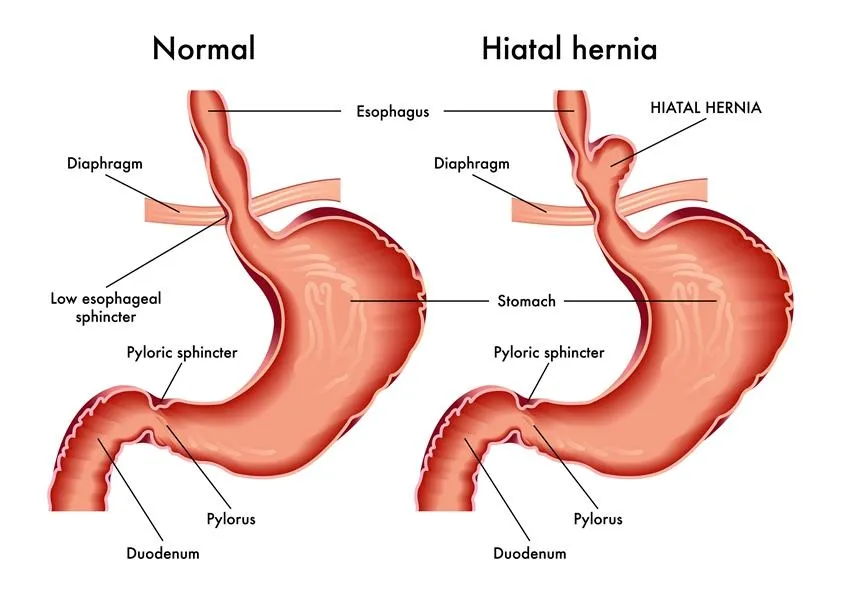
What Is Hiatal Hernia: Causes, Symptoms, & Treatment
A hiatal hernia (or hiatus hernia) occurs when the upper part of the stomach pushes through the diaphragm and enters the chest. The diaphragm is a muscular layer that separates the chest from the abdomen. People with a hiatal hernia can experience heartburn, acid reflux, and chest pain.
The condition might sound severe but it’s actually pretty common, especially as you get older. Most people only experience mild symptoms of acid reflux (or no symptoms at all). However, in extreme cases, surgery or medication might be needed to manage the condition.
What Is a Hiatal Hernia?
A hiatal hernia is the presence of the stomach above the diaphragm. Your diaphragm is a muscular barrier separating the abdominal cavity from the chest cavity and helps you breathe. If there is weakness in the diaphragm, increased abdominal pressure can push the stomach upwards.
It’s also known as a hiatus hernia or esophageal hiatus. The condition develops slowly over many years.
Usually, food passes from the mouth into the throat, down the esophagus, to the stomach. The stomach and esophagus are separated by the lower esophageal sphincter (LES). With a hiatus hernia, the LES is weakened, increasing the risk of acid reflux and gastroesophageal reflux disease (GERD).
Types of Hiatal Hernias
There are two main types of hiatal hernias: sliding hiatal hernias and paraesophageal hiatal hernias. These are classified into four categories:
Type 1, or a sliding hiatal hernia, accounts for 95% of all cases. The stomach and esophagus slide up through the widened hiatus and back down again.
Type 2 is the first of three paraoesophageal hiatal hernias. Meaning “beside the esophagus,” this condition involves the stomach pushing up alongside the esophagus, forming a bulge. Also called a rolling hiatal hernia.
Type 3 is a combination of type 1 and 2. Part of the stomach bulges alongside the esophagus, while another part slides in and out.
Type 4 is relatively rare. Here, the hiatus is wide enough for other organs to enter the chest cavity, such as your intestines, pancreas, or spleen.
Symptoms of a Hiatal Hernia
Most people with a hiatal hernia (especially type 1) will not experience any symptoms. If symptoms occur, they’re often linked to GERD and acid reflux. These symptoms include:
Heartburn or acid reflux
Regurgitation of food or sour liquid
Difficulty swallowing
Chest or upper abdominal pain
Feeling full quickly after eating
Shortness of breath (in larger hernias)
If left untreated, severe acid reflux (caused by a hiatal hernia) can cause changes in the esophageal lining. If you notice any vomiting blood, coffee-ground vomit, or passing black stool, seek immediate medical attention – it is a potential sign of cancer.
What Causes a Hiatal Hernia?
The term “hernia” describes any internal part of the body pushing through a weak spot in the surrounding muscle or tissue wall. Usually, a hiatal hernia refers to an abdominal hernia, where the intestines protrude out of the abdomen.
If a weak spot develops in the diaphragm, the stomach can begin to push through. This is a gradual process, with the hiatus incrementally increasing due to years of stress and strain. Anything that raises the abdominal pressure will wear on your diaphragm over time.
Common causes include:
Persistent coughing or sneezing
Long-term constipation and straining
Obesity (BMI over 30)
Frequent vomiting
Heavy lifting or intense exercise
Pregnancy and childbirth
More rarely, a hiatal hernia can occur as a result of a specific injury, surgery, or a birth defect. This creates the initial weakness, which worsens over time. Often, these conditions present with more severe hiatal hernias as they’ve had more time to develop.
Diagnosing a Hiatal Hernia
The simplest way to diagnose a hiatal hernia is to visualize what’s going on inside. Your doctor may recommend these tests:
Barium swallow—a person drinks a cup of barium, which allows the esophagus and stomach to be seen on an X-ray. It can provide a clear image of where the stomach is within the chest or abdomen.
Endoscopy – a thin, flexible tube with a camera on the end is passed down the esophagus and into the stomach. It can be seen directly if the stomach is pushing on the diaphragm, along with any obstructions or strangulation.
Esophageal manometry – a thin, flexible tube with pressure sensors is passed through the nose and down into the stomach. The measured pressures can detect the presence of a hiatus hernia as well as accurately measure its size. It can also help distinguish a hiatal hernia from other esophageal motility disorders, such as Achalasia.
Treatment of Hiatal Hernias
Most people with a hiatal hernia won’t require any treatment. It’s a normal part of aging. However, if the hiatal hernia is causing recurrent acid reflux (or GERD), it’s advisable to seek treatment.
Your doctor may recommend:
Antacids – to neutralize the acid during an attack.
Proton pump inhibitors (PPIs) – to prevent stomach acid production.
H2-receptor blockers – to lower stomach acid production.
Lifestyle changes may also be necessary, including cutting out foods that cause reflux symptoms.
Struggling with persistent regurgitation or acid reflux symptoms? If you’re dealing with a hiatal hernia, we can help. Learn more about our testing options and take the first step towards a clear diagnosis and effective treatment plan.

